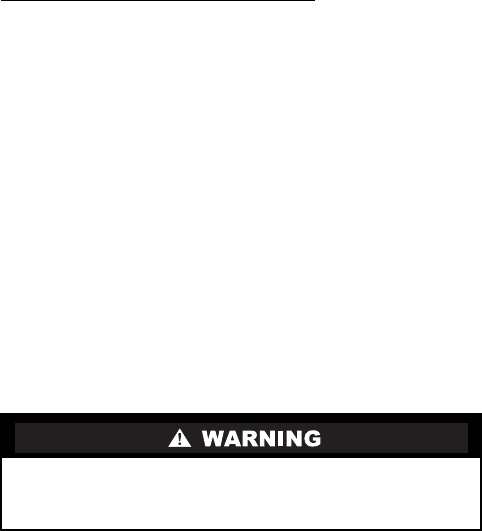
34
START-UP
Unit Preparation —
Make sure that unit has been in-
stalled in accordance with these installation instructions and
applicable codes. Make sure that Start-Up Checklist, located on
back page of this booklet, has been completed and filled out.
Return-Air Filters —
Make sure correct filters are in-
stalled in filter tracks (see Tables 1A and 1B). Do not operate
unit without return-air filters.
Outdoor-Air Inlet Screens —
Outdoor-air inlet screens
must be in place before operating unit.
Compressor Mounting —
Compressors are internally
spring mounted. Do not loosen or remove compressor hold-
down bolts. On 48TF014 units, remove the tiedown bands that
hold the compressors together.
Internal Wiring —
Check all electrical connections in
unit control boxes. Tighten as required. Ensure wiring does not
come into direct contact with refrigerant tubing.
Refrigerant Service Ports —
Each refrigerant sys-
tem has 4 Schrader-type service gage ports: one on the suction
line, one on the liquid line, and two on the compressor dis-
charge line. Be sure that caps on the ports are tight. One
Schrader-type valve is located under both the high-pressure
switch and the low-pressure switch when ordered as an option.
High Flow Valves —
Located on the compressor hot gas
and suction tubes are High Flow Valves. Large black plastic
caps distinguish these valves with O-rings located inside the
caps. These valves cannot be accessed for service in the field.
Ensure the plastic caps are in place and tight or the possibility
of refrigerant leakage could occur.
Compressor Rotation —
On 3-phase units with scroll
compressors, it is important to be certain compressor is rotating
in the proper direction. To determine whether or not compres-
sor is rotating in the proper direction:
1. Connect service gages to suction and discharge pressure
fittings.
2. Energize the compressor.
3. The suction pressure should drop and the discharge pres-
sure should rise, as is normal on any start-up.
If the suction pressure does not drop and the discharge pres-
sure does not rise to normal levels:
1. Note that the evaporator fan is probably also rotating in
the wrong direction.
2. Turn off power to the unit and install lockout tag.
3. Reverse any two of the unit power leads.
4. Reapply power to unit. Reenergize compressor.
The suction and discharge pressure levels should now move
to their normal start-up levels.
NOTE: When the compressor is rotating in the wrong direc-
tion, the unit will make an elevated level of noise and will not
provide cooling.
Cooling —
To start unit, turn on main power supply. Set
system selector switch at COOL position and fan switch at
AUTO. position. Adjust thermostat to a setting below room
temperature. Compressor, indoor and outdoor fans start on clo-
sure of contactors.
Check unit charge. Refer to Refrigerant Charge section,
page 37. Unit must operate a minimum of 15 minutes before
adjusting charge.
Reset thermostat at a position above room temperature.
Compressor and outdoor fans will shut off. Evaporator fan will
shut off after 30-second delay.
TO SHUT OFF UNIT — Set system selector switch at OFF
position. Resetting thermostat at a position above room tem-
perature shuts unit off temporarily until space temperature ex-
ceeds thermostat setting.
Main Burners —
Main burners are factory set and should
require no adjustment.
TO CHECK ignition of main burners and heating controls,
move thermostat set point above room temperature and verify
that the burners light and evaporator fan is energized. After en-
suring that the unit continues to heat the building, lower the
thermostat setting below the room temperature and verify that
the burners and evaporator fan turn off (fan will turn off only if
fan selector switch is in the AUTO. position). Refer to Table 24
for the correct orifice to use at high altitudes.
NOTE: Upon a call for heat, the main burners will remain on
for a minimum of 60 seconds.
ADJUST GAS INPUT — The gas input to the unit is deter-
mined by measuring the gas flow at the meter or by measuring
the manifold pressure. Manifold pressure should be 872 Pa
(3.5 in. wg).
NOTE: Unit uses a 2 stage gas valve. There is no need to
adjust the “Low Fire” manifold pressure.
Measure Gas Flow (Natural Gas Units)
— Minor adjustment
to the gas flow can be made by changing the manifold pressure.
The manifold pressure must be 872 Pa (3.5 in wg). Normal
manifold pressure is 872 Pa (3.5 in. wg) in high fire, W1 and
W2 inputs to gas valve.
Proceed as follows:
1. Turn off gas supply to unit.
2. Remove pipe plug on manifold then connect manometer
at this point. Turn on gas to unit. Ensure gas valve is in
high fire operation.
Observe manifold pressure and proceed as follows to adjust
gas input:
1. Remove cover screw over regulator adjustment screw on
gas valve. Ensure gas valve is operating in high fire
mode.
2. Turn regulator adjustment screw clockwise to increase
gas input, or turn regulator adjustment screw counter-
clockwise to decrease input. High fire manifold pressure
must be 872 Pa (3.5 in. wg).
3. Replace cover screw cap on gas valve.
4. Turn off gas supply to unit. Remove manometer from
pressure tap and replace pipe plug on gas valve. Turn on
gas to unit and check for leaks.
Heating
1. Purge gas supply line of air by opening union ahead of
gas valve. When gas odor is detected, tighten union and
wait 5 minutes before proceeding.
2. Turn on electrical supply and open manual gas valve.
3. Set system switch selector at HEAT position and fan
switch at AUTO. or ON position. Set heating temperature
lever above room temperature.
4. The induced-draft motor will start, purging heat
exchangers.
Unsafe operation of the unit may result if manifold pres-
sure is outside 847 to 897 Pa (3.4 to 3.6 in. wg) range. Per-
sonal injury or unit damage may result.
